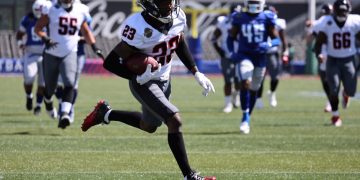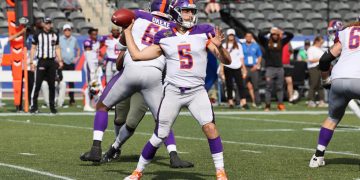Sports betting is no longer just for betting professionals, in fact, anyone of legal age can bet on sports. As more and more states legalize sports betting (including legal online sports betting), finding a safe place to bet on sports is easy.
Knowing how to read sports odds is a key component to successful sports betting. Fortunately, understanding sports betting odds is quite straightforward. There are essentially three types of betting odds to choose from at most online sportsbooks:
- American odds
- Decimal odds
- Fractional odds
You will also find these sports odds at brick and mortar sports betting venues. Therefore, knowing how all the betting odds and various betting options work is vital to your success. Signing up with a reputable online sportsbook will allow you to try out some of these betting options at no risk, since top sportsbooks offer free bets as a sign-up incentive. That said, it is equally important to always play responsibly in order to avoid any future potential gambling problem.
Our complete guide on how to successfully read sports odds explains each of these options in simple terms. Learn to bet with confidence once you understand how to:
- Use different types of sports odds
- Calculate sports betting odds
- Read sports betting lines
- Calculate winnings
- Calculate payouts
- Use odds to make multiple bets
- Understand a push result
What Are American, Decimal, & Fractional Odds?
Most online sportsbooks will give you the option of choosing which betting odds you’d prefer to bet with. While the three main sports betting odds options are American, Decimal and Fractional, you’ll find some others including:
- Hong Kong sports odds
- Indonesian betting odds
- Malay betting odds
- Implied Probability sports odds
- Vegas odds
- Futures odds
However, the three types of betting odds that we’ll discuss here are the most common or most popular.
It is interesting to note that fractional odds are sometimes referred to as UK odds, while decimal odds are sometimes referred to as European odds. It all depends on the online gambling sites that you tend to frequent.
Learning how to read sports betting odds within each available system will give you far greater flexibility in your sports betting. Whether you’re into horse racing, sports betting, NFL or NHL the following explanations of each type of odds will help you make the right choices.
Get Exclusive SportsBook Promo Codes
American Odds Explained
As you may have guessed, American odds are most popular in American sports and betting markets. However, you will also find American odds offered in most non-US sportsbooks and online sports betting sites.
American odds are also sometimes referred to as moneyline odds or moneyline bets. These types of sports bets are very popular due to their simplicity. Essentially, with a moneyline bet, you’re betting on an outright winner between two teams.
With a money line bet, you’re either betting that the favoured team wins, or that the underdog has the better chance of winning.
Of course, you will not get the same odds for both teams. With American odds, bookmakers will either use a plus (+) symbol, or a minus (-) symbol to differentiate betting odds.
What Do the + and – Mean in Sports Betting?
American sports betting odds are instantly recognizable, thanks to their use of a positive number or a negative number. But how does this work and how can it help you to read betting odds?
Let’s look at the positive American odds first:
When using the American betting odds formula, a positive odds number indicates an underdog bet. For example:
Pittsburgh Stealers +200
Cleveland Browns -235
In this hypothetical betting line, the Stealers are not favored to win. So, in American betting odds, the positive number tells you how much you would win if you bet $100, in this case, on the Stealers to win.
Implied probability is the process of converting betting odds into a percentage. It essentially let’s you know what the bookmaker expects the probability of a particular outcome to be. It is possible to calculate implied probability with positive American odds by using this formula:
Implied probability of a particular outcome = 100 / (positive American odds + 100)
Now, let’s look at negative American odds:
When you see American odds expressed as negative odds(-), this indicates that the bookmaker has listed the team as favorite to win the game. So, if we were to take the same betting line as shown earlier:
Pittsburgh Stealers +200
Cleveland Browns -235
The favorite to win would be the Cleveland Browns. However, this time around, the -235 indicates how much you would need to be in order to win $100. Once again implied probability can also be used with negative American odds. This time, the formula would look something like this:
Implied probability of a particular outcome = negative American odds / (negative American odds + 100)
When it comes to calculating winnings using American odds, there are two different formulas that you can make use of.
Calculating how much profit is made with positive American odds:
Solve for x by using the following equation:
100/odds = wager/x
When it comes to calculating winnings with negative American odds:
X represents winnings in the following formula:
Odds/100 = wager/x
Decimal Odds Explained
Now that we have a good idea of how American odds work, let’s take a closer look at the next of the three main betting odds options – decimal odds.
You’ll find that decimal odds are most often used (popular) in European gambling sites and online sports betting sites. Decimal odds are also popular in Canada, the UK and Australia. Decimal odds will sometimes be referred to as ‘European odds’, depending on the sports betting site in question.
Decimal odds are also the most popular because they are the easiest to work with. This is because the decimal odds value that is given will be paid out for a winning bet.
For example:
If the decimal odds posted = 2.40
This will be the figure used to calculate your winnings.
Calculating Winnings with Decimal Odds
Calculating payouts when using decimal odds is very easy to do. To explain how to calculate your winnings when using decimal odds, let’s use our previous sports betting lines:
Pittsburgh Stealers 2.40
Cleveland Browns 1.61
With decimal odds, if you were to bet $75 on the Stealers to win (decimal odds of 2.40), you would use the following formula to calculate your winnings:
winning bet = (75 x 2.40) -75 = $105
Alternatively, if you were to bet $75 on the Browns to win (decimal odds of 1.61), calculating your winnings would look like this:
winning bet = (75 x 1.61) – 75 = $45
We can also calculate the implied probability when using decimal odds. This is what the implied probability formula would look like when in the decimal odds mode:
Implied probability = 100decimal odds
To use this practically, we’ll stick with our previous betting lines.
Our Pittsburgh Stealers bet offered decimal odds of 2.40
To calculate the implied probability of this bet:
12.40 = 41.7%
Similarly for our Cleveland Browns decimal odds bet:
11.61 = 62.11%
As you can no doubt see from the above results, the bookmaker believes that the probability of the Browns winning is higher than for the Stealers.
Fractional Odds Explained
The last of the three different formats used in posting betting odds that we’ll be looking at is fractional odds. Fractional odds are most commonly used at UK bookmakers and online sports betting sites. You will also find that fractional odds are most often used for horse racing as well.
Perhaps out of the three main betting odds options, fractional odds look the most confusing or intimidating. This is probably because of the way that fractional odds are presented:
For example: 1/2, 7/4, 9/5 and so on.
For American sports bettors, fractional odds are common at top horse racing events like the Kentucky Derby, Belmont Stakes and the Preakness Stakes. These three races are collectively known as the American Triple Crown sporting event.
The way to read sports betting lines presented as fractions is to say “one to two” when the fraction is 1/2, or “nine to five” when the fraction is 9/5 and so forth. Apart from how to say fractional odds out loud, let’s look at how fractional odds work in practice.
Let’s assume our fractional odds for a given sports event are 7/5:
With fractional odds, the number on the left (7) tells you the number of times that the bookmaker believes that the relevant outcome will fail/lose. The number on the right (5) tells you the number of times that the bookmaker believes that the relevant outcome will succeed/win.
The split in fractional odds when added together will give you the total number of times the event could play out. In other words, 7/5, when added gives you 12 times or 7+5.
This can be better explained when using a sports betting scenario:
In the upcoming boxing match between Chris Eubank Jr vs Conor Benn, let’s assume that Eubanks has been given odds of 8/13. This would mean that, if the fight had to occur 21 times (add 8 and 13), Eubanks would end up losing 8 times but would win 13 times.
One can also calculate the implied probability of this fractional odds bet:
If we take the number of times that Eubanks is predicted to win (13) and divide this number by the total number of tries (21), we arrive at a 61.9% probability of Eubanks winning the fight.
This is how it looks expressed as a formula:
Implied probability = DenominatorDenominator + Numerator
13(13+8) = 1321 = 61.9%
What about the other side of this sports bet?
To work out the probability of a Conor Benn win, we do the same steps. For the sake of this scenario, let’s say that Benn’s odds are 11/8.
This then implies that, if the fight occurred 19 times (add 11 to 8), Benn would lose 11 times and win 8 times. To calculate the probability of Benn winning the match, divide the number of win times (8) by the total number of event times (19). This will yield an implied probability of 42.1%.
Expressed as an equation:
Implied probability = DenominatorDenominator + Numerator
8(8+13) = 821 = 42.1%
What is a Push?
The difference between all the betting odds explained thus far and a push, is that a push is technically not related to any of them. This is because a ‘push’ is essentially a ‘tie’ result. However, it is important to know where push results might occur.
For instance, you won’t find a push result in moneyline bets. This is because money line bets will give you a tie result as a betting option. That said, you will find a push result in point spread betting or in total bets. For a push result to occur, both team scores must be zero. Alternatively, both teams must tie with the same number of goals.
In the event of a push result, you will be refunded your wager and no win or loss will be recorded. It is also worth noting that point spread bets will usually include a half point to both numbers. This is done in order to avoid the potential of a push result.
How to calculate payouts
Knowing how to read sports odds effectively is one half of the battle. Calculating your total payout is the other half. It is vitally important to be able to project potential winnings before placing any sports bet. After all, you need to have an idea that a potential bet is worth your while (and your money).
Calculating your payout depends on the type of sports betting odds being used. Each works slightly differently from the others. Let’s see how to calculate payouts based on decimal odds, fractional odds and American odds format.
Calculating payout using decimal odds
Decimal odds are considered the easiest to work with, both for placing value bets and working out bet wins and payouts.
To understand payout calculations, let’s look at two hypothetical teams – A and B.
Now, let’s assume that these two teams have been given the following odds:
Team A – 1.50
Team B – 4.50
We can deduce from these posted sports odds that Team A is the favorite to win. This is because the odds are lower. Thus, Team B is the underdog since its posted odds are higher.
To calculate your payout based on the above information, simply multiply your bet amount to the odds of the team that you bet on.
For example: you bet $10 on Team A. Your total payout will be $15 ($10 x 1.50). This gives you a net profit of $5.
Calculating payout using fractional odds
As mentioned earlier, fractional odds are popular for horseracing, boxing and other sports. Also known as UK odds, fractional odds can take a bit of getting used to. Fractional odds vary, but common examples include 2/3, 7/8, 5/2, 9/5 etc.
To begin understanding how to calculate payout when using fractional odds, it’s important to remember that fractional odds show how much you need to bet in order to win a given payout.
Fractional odds structure:
Left number = numerator – potential payout
Right number = denominator – required bet
Let’s use our Team A and B betting line again:
Team A – 4/6
Team B – 6/5
The easiest way to calculate your payout in this scenario is if the given bet is a multiple of the denominator. In other words, you bet $50 on Team B to win. If they win, you get $110 as your final score payout. This payout breaks down as $60 profit along with your original $50 bet back (6/5).
What if you decide to bet an odd amount?
In that case, you would need to apply a slightly different formula. For our example, we’ll assume a bet of $21 on Team B to win. Calculate your payout by dividing the given bet by the denominator, then multiply by the denominator, then add the given bet amount again.
For example:
[($21/5) x 6)] +21 = $46.2 total winning payout
Calculating payout using American odds
American odds, also known as moneyline odds, are very easy to understand when it comes to how to read odds. American odds are used mainly in US sports like NFL football, NBA and MLB.
American odds are all about win betting in multiples of $100. In other words, it indicates how much you have to bet based on the available odds. This system uses either negative numbers or positive numbers to indicate favorite to win or underdog.
Here’s an example:
Team A – 250
Team B +200
We can see from this betting line that Team A is the favorite to win based on the minus odds given. On the other side of the coin, Team B is the underdog based on the positive odds given. If you bet on Team A to win, the odds indicate how much you would need to bet in order to see a profit of $100. So you would need to bet $250. If you bet on Team B to win, the number indicates your profit if you bet $100. Your profit would be $200.
How to Read Sports Odds FAQs
How to read betting odds?
Knowing read sports betting odds is based on the type of odds that you are presented with. Each type requires a slightly different approach. For example, reading American betting odds means that you look at the + or the – sign applied before the number. The + indicates an underdog bet, while a – indicates a favorite to win bet.
To read decimal betting odds, the lower the decimal value, the more favored the team is to win. Simply times your bet amount by the decimal odds value to figure out your payout for a win. Fractional odds may seem hard to read at first but are easy once you know how. The fraction is made up of a left number (numerator) and a right number (denominator), eg: 4/6. The left number indicates your potential payout, while the right number indicates the required bet amount.
What does + mean in betting?
The + in betting can be used in several betting odds including spread bets (point spreads) and money line bets (American odds). For example, in point spread betting a +7 spread may be set for the underdog team. In this case, the underdog team is required to either win the game outright, or not lose by more than seven points. In moneyline or American odds, the + is used to indicate the underdog bet.
What do odds of +200 mean?
Odds of +200 applies to moneyline bets or American odds betting system. In American odds, all bets are based on $100 bets. Positive odds (+ sign) followed by a number refers to your potential profit on a bet of $100. If you see a +200 posted as positive odds on a moneyline bet or American odds, this means that you will win $200 for every $100 bet that you place.
What do odds +100 mean?
Like the +200-money line bet, getting odds of +100 means that you can potentially win the same amount that you bet. This is because American odds work on bets of $100. If you bet $100 on the underdog team winning (+), you will win $100 if they win the game.
What do odds 3 to 1 mean?
The 3 to 1 betting odds option is based on four possible outcomes. In other words, the odds are such that there will be 3 of the same result versus 1 of a different result. In practical terms this simply means that for every 4 betting opportunities, your bet will win 1 time and will not win the other 3 times.







